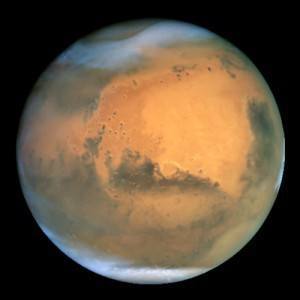
The carbon dioxide snowflakes vary in size from the north pole to the south pole
Mars has carbon dioxide snowflakes it seems, according to MIT researchers, though you won’t be able to mold them into a loveable Frosty the Snowman-type Martian as the snow particles are approximately the size of a human red blood cell.
“These are very fine particles, not big flakes,” said Kerri Cahoy, an assistant professor of aeronautics and astronauts at the Massachusetts Institute of Technology. According to Cahoy, Mars snowflakes would resemble a fog to the naked eye “because they’re so small.”
“For the first time, using only spacecraft data, we really revealed this phenomenon on Mars,” said Renya Hu, a graduate student who worked with Cahoy and Maria Zuber, a geophysics professor at MIT.
The researchers studied the Martian poles where temperatures in winter become cold enough to condense carbon dioxide gas into particles that resemble snow, but at only a fraction of the size.
As current Mars landers are incapable of surviving conditions at the poles, according to National Geographic, the researchers were able to reach their conclusion by using nine years’ worth of data (five Mars years), from the Mars Global Surveyor and Mars Reconnaissance Orbiter, among other resources.
“It’s neat to think that we’ve had spacecraft on or around Mars for over 10 years, and we have all these great datasets,” said Cahoy. “If you put different pieces of them together, you can learn something new just from the data.”
According to a post-doctoral student in planetary sciences at the California Institute of Technology not involved in the research, Paul Hayne, “The big-picture question this addresses is how the seasonal ice caps on Mars form. The ice could be freezing directly as the surface, or forming as snow particles in the atmosphere and snowing down on the surface . . . this work seems to show that at least in some cases it’s snowfall rather than direct ice deposition. That’s been suspected for a long time, but this may be the strongest evidence.”
According to National Geographic, the mass of snow and ice deposits each winter is enough to alter the Martian gravitational field, although by a tiny amount.
The researchers were able to pinpoint the size of snow particles at both Martian poles. At the south pole, Mars snowflakes were found to range from 4 to 13 microns. In comparison, at the north pole, where the Martian atmosphere is much denser, the carbon dioxide snowflakes range from 8 to 22 microns. In contrast, snowflakes here on Earth average an approximate width of ten millimeters. The average human red blood cell is 6 to 8 microns in width, according to National Geographic.
















.jpeg)

